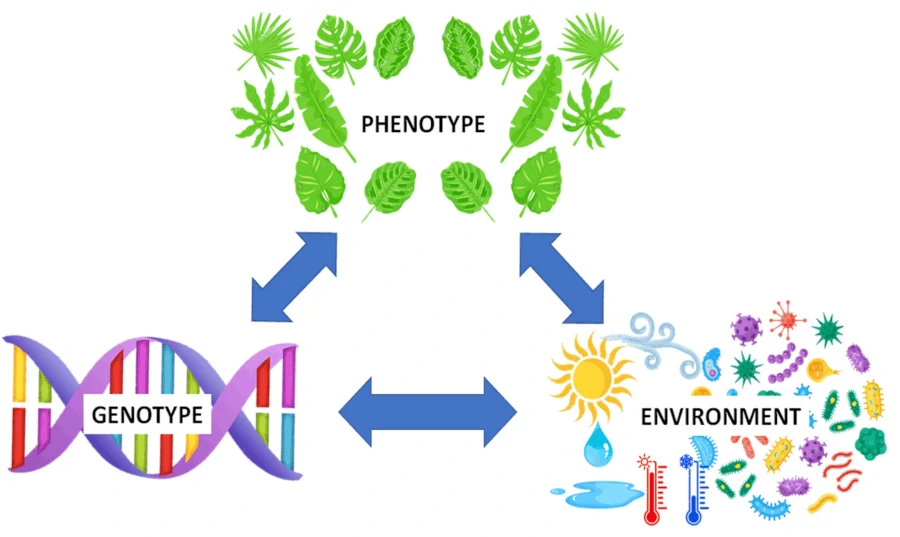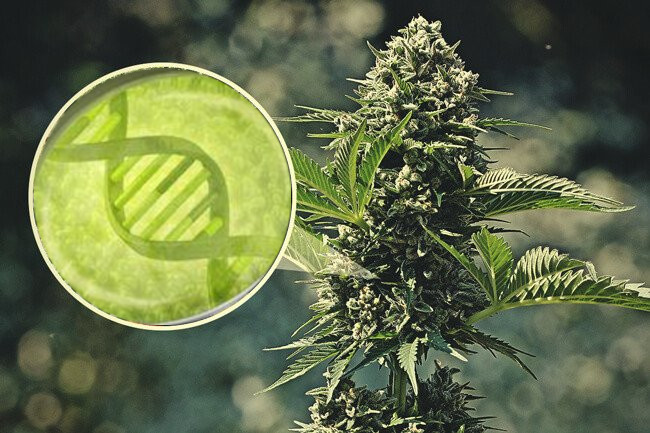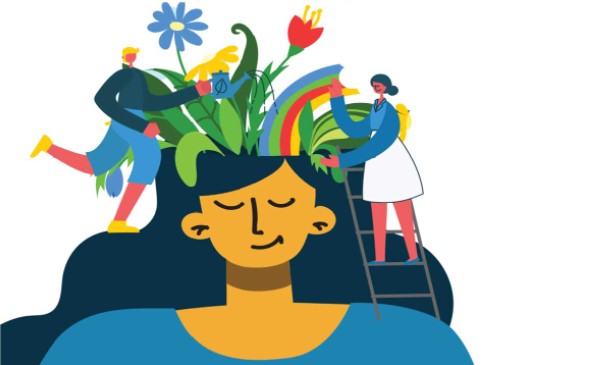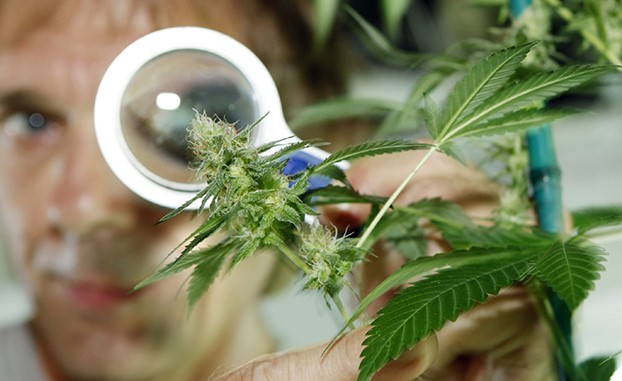Embark on a captivating journey into the intricate world of cannabis as we delve into the dynamic relationship between phenotype and genotype. From the genetic blueprint encoded within cannabis DNA to the observable traits that manifest during cultivation, this exploration unveils the secrets behind the diverse spectrum of cannabis varieties. Join us in deciphering the complexities of genotype and phenotype, understanding how these fundamental elements shape everything from the plant’s growth patterns to its therapeutic and recreational effects. Let’s unravel the genetic tapestry that defines the cannabis experience and gain valuable insights that empower cultivators and enthusiasts alike.
Table of Contents:
- Defining the Basics
- 1.1 Understanding Genotype
- 1.2 Unveiling Phenotype
- 1.3 The Interplay between Genotype and Phenotype
- Genotype: The Genetic Blueprint
- 2.1 Genetic Makeup of Cannabis
- 2.2 Inheritance and Genetic Variation
- 2.3 The Role of DNA in Cannabis Genotype
- Phenotype: The Expression of Traits
- 3.1 Phenotypic Traits in Cannabis
- 3.2 Environmental Influences on Phenotype
- 3.3 Unmasking Phenotype through Observation
- Cultivation Impact: Nurturing Genetics for Desired Traits
- 4.1 Selective Breeding and Genotype Modification
- 4.2 Cultivation Practices and Phenotypic Expression
- 4.3 Challenges in Maintaining Desired Traits
- Consumption Considerations: Phenotype and Cannabis Effects
- 5.1 The Relationship between Phenotype and Cannabinoid Profile
- 5.2 Aroma, Flavor, and Phenotypic Expression
- 5.3 Tailoring Cannabis Consumption Based on Genotype
- Case Studies: Examining Phenotype and Genotype in Popular Strains
- 6.1 Investigating Notable Cannabis Strains
- 6.2 How Genotype Shapes Strain Characteristics
- 6.3 Uncovering the Influence of Phenotype on User Experience
- Future Frontiers: The Role of Phenotype and Genotype in Cannabis Research
- 7.1 Advancements in Cannabis Genomics
- 7.2 Implications for Medicinal Cannabis Research
- 7.3 Potential for Customized Cannabis Products
- Conclusion: Harmonizing Genotype and Phenotype for Cannabis Enthusiasts
- 8.1 Embracing Diversity in the Cannabis Spectrum
- 8.2 Empowering Cultivators and Consumers with Knowledge
- 8.3 The Ever-Evolving Story of Cannabis Phenotype and Genotype

1. Defining the Basics
Understanding the fundamental concepts of phenotype and genotype lays the groundwork for navigating the intricate world of cannabis cultivation and consumption. In this section, we delve into the core definitions and explore the dynamic relationship that exists between genotype and phenotype.
1.1 Understanding Genotype
Genotype, at its essence, refers to the genetic blueprint encoded within the DNA of an organism. In the context of cannabis, the genotype represents the specific combination of genes that dictate the plant’s inherent characteristics. These genetic instructions determine various traits such as the plant’s growth structure, resistance to pests, cannabinoid production, and more.
The cannabis genotype is like a set of instructions passed down from one generation to the next, encapsulated within the plant’s DNA. This genetic code acts as a foundation, influencing how the plant will develop and express itself throughout its life cycle. Understanding the genotype is essential for cultivators seeking to harness specific traits or characteristics in their cannabis crops through selective breeding and genetic manipulation.
1.2 Unveiling Phenotype
In contrast to genotype, phenotype refers to the observable traits and characteristics of an organism. When applied to cannabis, the phenotype encompasses features such as plant height, leaf structure, flower color, aroma, and cannabinoid content. Unlike the fixed nature of genotype, the phenotype is the dynamic expression of these traits influenced by both genetic factors and the environment in which the plant grows.
Unveiling the phenotype involves keen observation of the physical attributes exhibited by a cannabis plant. This can vary even among plants with identical genotypes due to environmental influences. Phenotypic expression is a result of the interplay between the genetic code (genotype) and external factors such as light, temperature, humidity, and nutrient availability.
1.3 The Interplay between Genotype and Phenotype
The relationship between genotype and phenotype is a nuanced dance of nature and nurture. While the genotype sets the stage by providing the genetic instructions, the phenotype represents the real-time manifestation of those instructions under the influence of environmental conditions. This interplay is crucial in understanding how different strains of cannabis can exhibit diverse traits, even when originating from similar genetic backgrounds.
Cultivators and researchers keen on manipulating the characteristics of cannabis must appreciate the delicate balance between genotype and phenotype. Recognizing this interplay empowers growers to make informed decisions, whether in selecting breeding pairs, optimizing cultivation conditions, or tailoring cannabis products to meet specific consumer preferences. In the subsequent sections, we delve deeper into the intricacies of genotype and phenotype, exploring their implications for cannabis cultivation and consumption.
2. Genotype: The Genetic Blueprint
Understanding the genetic blueprint of cannabis is akin to deciphering the language written in its DNA. This section explores the intricate details of the genotype, from the overall genetic makeup to the mechanisms of inheritance and genetic variation, shedding light on the role of DNA in shaping the cannabis genotype.
2.1 Genetic Makeup of Cannabis
The genetic makeup of cannabis is an elaborate sequence of nucleotides arranged in a unique order within its DNA. These nucleotides form genes, which are the functional units responsible for encoding specific traits. The cannabis genome comprises various genes that determine the plant’s characteristics, including growth patterns, flowering times, and the production of cannabinoids and terpenes.
Within the cannabis genome, there are specific regions responsible for encoding enzymes involved in cannabinoid and terpenoid biosynthesis. Understanding these genetic components is pivotal for breeders and researchers aiming to manipulate the plant’s traits through selective breeding or genetic modification. Advances in genomic research have enabled the identification and characterization of these key genetic elements, providing valuable insights into the intricacies of the cannabis genetic code.
2.2 Inheritance and Genetic Variation
Inheritance plays a central role in the transmission of genetic information from one generation of cannabis plants to the next. Cannabis, like other living organisms, follows the principles of Mendelian genetics, where traits are passed down through the combination of genetic material from both parent plants. The study of inheritance patterns is crucial for predicting the traits that offspring may inherit based on the genetic makeup of the parent plants.
Genetic variation, on the other hand, introduces diversity within a population. Cannabis exhibits considerable genetic variability, allowing for the development of a wide array of strains with distinct characteristics. Factors such as crossbreeding and hybridization contribute to the introduction of new genetic material, fostering diversity and adaptation within the cannabis gene pool.
2.3 The Role of DNA in Cannabis Genotype
DNA, or deoxyribonucleic acid, is the molecular code that holds the instructions for building and maintaining an organism. In cannabis, DNA serves as the architectural plan for the plant’s development and function. The sequence of nucleotide bases—adenine (A), thymine (T), cytosine (C), and guanine (G)—forms the genetic code, and specific sequences within this code dictate various aspects of the cannabis genotype.
The role of DNA in the cannabis genotype extends beyond simple inheritance. It governs the synthesis of proteins, enzymes, and other molecules essential for the plant’s growth, metabolism, and response to environmental stimuli. As researchers unravel the intricacies of the cannabis genome, the role of DNA becomes a focal point in understanding how to manipulate and optimize the plant’s traits for desired outcomes.
In the subsequent sections, we explore how this genetic blueprint manifests in the physical characteristics of cannabis (phenotype) and its implications for cultivation practices and consumption experiences.
3. Phenotype: The Expression of Traits
Understanding phenotype is like unraveling the story written by the genetic script—how the cannabis plant manifests its traits in response to both genetic instructions and environmental influences. In this section, we explore the distinctive traits that characterize cannabis phenotypes, the impact of the environment on their expression, and the art of unmasking phenotype through careful observation.
3.1 Phenotypic Traits in Cannabis
Phenotypic traits in cannabis encompass a diverse range of characteristics that can be observed and measured. These traits include but are not limited to plant structure, leaf morphology, flower color, aroma, and the composition of cannabinoids and terpenes. Each cannabis strain possesses a unique combination of these traits, contributing to the vast array of options available to cultivators and consumers.
Understanding phenotypic traits is crucial for cultivators aiming to produce cannabis with specific characteristics. Whether the goal is to cultivate a strain with high cannabinoid content, unique flavors, or distinctive growth patterns, a keen awareness of phenotypic expression guides cultivation practices and selective breeding decisions.
3.2 Environmental Influences on Phenotype
While the genotype sets the stage for phenotypic expression, the environment in which a cannabis plant grows plays a pivotal role in shaping its observable traits. Environmental factors such as light intensity, temperature, humidity, soil composition, and nutrient availability can significantly influence how the genetic instructions are translated into physical attributes.
For example, variations in light cycles during the flowering stage can impact the timing and intensity of cannabinoid production. Similarly, fluctuations in temperature and humidity may influence the expression of terpenes, the aromatic compounds responsible for the distinct smells associated with different cannabis strains.
Cultivators must be attuned to these environmental influences to optimize the expression of desired traits in their cannabis plants. Through careful manipulation of cultivation conditions, growers can enhance specific characteristics and tailor the phenotype to meet consumer preferences.
3.3 Unmasking Phenotype through Observation
Unmasking the phenotype involves a meticulous process of observation throughout the cannabis plant’s life cycle. From seedling to harvest, cultivators and researchers keen on understanding and optimizing phenotypic expression must closely monitor the development of various traits.
Observation includes noting the growth patterns, leaf morphology, and overall health of the plant. During the flowering stage, attention shifts to the development of flowers, their color, size, and resin production. The olfactory senses also come into play, as the aroma emitted by the plant provides insights into the terpene profile, contributing to the overall phenotypic character.
Through keen observation, growers can identify standout plants with desired traits, facilitating the selection of breeding pairs for future generations. Additionally, understanding the influence of the environment allows cultivators to make informed decisions to enhance or mitigate specific phenotypic characteristics.
As we proceed, we’ll explore how the interplay between genotype and phenotype influences the cultivation of cannabis, impacting the quality and diversity of products available to consumers.
4. Cultivation Impact: Nurturing Genetics for Desired Traits
Cultivation is the art of harnessing the potential encoded in the genetic blueprint to produce cannabis with specific and desirable traits. In this section, we explore the transformative practices of selective breeding and genotype modification, the influence of cultivation practices on phenotypic expression, and the challenges inherent in maintaining desired traits over time.
4.1 Selective Breeding and Genotype Modification
Selective breeding is a cornerstone of cannabis cultivation, allowing growers to emphasize and perpetuate desirable traits while minimizing undesirable characteristics. Through meticulous pairing of plants with specific genotypes, cultivators can influence the genetic composition of subsequent generations, gradually refining the traits that define a particular strain.
Genotype modification takes this process a step further, often involving advanced techniques such as genetic engineering or crossbreeding with specific goals in mind. Whether aiming for increased cannabinoid potency, unique terpene profiles, or enhanced resistance to environmental stressors, genotype modification provides a tool for cultivators to tailor cannabis genetics to meet evolving market demands.
While these techniques hold promise for innovation, ethical considerations and regulatory frameworks surround the practice of genetic modification, requiring a delicate balance between scientific advancement and responsible cultivation practices.
4.2 Cultivation Practices and Phenotypic Expression
Cultivation practices wield significant influence over the expression of phenotypic traits in cannabis. Factors such as light cycles, nutrient levels, and environmental conditions directly impact how the genetic instructions are translated into observable characteristics.
For instance, adjusting the light cycle during flowering can influence the timing and intensity of cannabinoid production. Similarly, nutrient deficiencies or imbalances can manifest in altered leaf color or growth patterns. Cultivators skilled in understanding these nuances can fine-tune cultivation practices to optimize the expression of specific phenotypic traits, resulting in a harvest that aligns with consumer preferences.
Precision in cultivation practices also extends to post-harvest processes, such as drying and curing, which can further enhance the flavor, aroma, and overall quality of the final product. The synergy between cultivation techniques and genetic potential allows cultivators to curate a diverse range of cannabis varieties tailored to different preferences and applications.
4.3 Challenges in Maintaining Desired Traits
Maintaining consistent and desired traits over multiple generations presents a unique set of challenges for cultivators. The dynamic nature of cannabis genetics, influenced by factors such as genetic recombination, mutation, and environmental variability, can introduce unpredictability in phenotypic expression.
Contamination from pollen drift or accidental cross-pollination poses a risk to the genetic purity of strains, potentially leading to unintended combinations of traits. Additionally, as cultivation practices evolve and strains adapt to new environments, there is a risk of genetic drift, where the genetic makeup gradually shifts over time.
Addressing these challenges requires ongoing vigilance, rigorous testing, and adherence to meticulous breeding protocols. Technologies like DNA testing and marker-assisted selection offer tools for cultivators to maintain genetic integrity and selectively propagate plants with the desired traits.
In the subsequent sections, we explore the impact of phenotype and genotype on cannabis consumption, examining how these factors shape the diverse landscape of cannabis products available to consumers.
5. Consumption Considerations: Phenotype and Cannabis Effects
The consumption of cannabis is a multifaceted experience, influenced by the intricate interplay of phenotype and genotype. This section delves into the relationship between phenotype and the cannabinoid profile, the impact of aroma and flavor on phenotypic expression, and the potential for tailoring cannabis consumption experiences based on genotype.
5.1 The Relationship between Phenotype and Cannabinoid Profile
Phenotype plays a pivotal role in determining the cannabinoid profile of a cannabis strain, directly influencing the effects it produces. While the genotype sets the potential for cannabinoid synthesis, the environmental conditions during cultivation, particularly light and nutrient availability, can significantly alter the final cannabinoid composition.
Understanding the phenotype of a cannabis strain provides consumers with insights into the potential effects they can expect. Strains with high levels of THC (tetrahydrocannabinol) are known for their psychoactive properties, while those rich in CBD (cannabidiol) offer potential therapeutic benefits without the intoxicating effects. Beyond THC and CBD, other cannabinoids, such as CBG (cannabigerol) and CBN (cannabinol), contribute to the overall effects of a strain.
Consumers seeking specific therapeutic outcomes or recreational experiences can benefit from considering the cannabinoid profile of a strain, which is intricately tied to its phenotype.
5.2 Aroma, Flavor, and Phenotypic Expression
The aromatic and flavor profile of cannabis, largely driven by terpenes, is a direct manifestation of phenotype. Terpenes are aromatic compounds that not only contribute to the distinct scents associated with different strains but also interact with cannabinoids to produce an entourage effect—a synergistic enhancement of therapeutic or psychoactive effects.
Phenotypic expression plays a central role in determining the terpene profile of a strain. Different combinations and concentrations of terpenes contribute to the unique aromas and flavors that make each strain distinctive. For example, strains with high levels of myrcene may exhibit earthy and musky aromas, while limonene-dominant strains present citrusy and lemon-like scents.
As consumers explore the diverse landscape of cannabis products, paying attention to the aromatic and flavor characteristics can enhance the overall experience. Cannabis enthusiasts often seek specific terpene profiles to tailor their consumption to personal preferences, whether for relaxation, focus, or invigoration.
5.3 Tailoring Cannabis Consumption Based on Genotype
The genotype of a cannabis strain lays the foundation for its potential effects, but tailoring consumption experiences often involves a nuanced understanding of both genotype and phenotype. For instance, two plants with identical genotypes may exhibit variations in cannabinoid and terpene profiles due to environmental influences.
Consumers interested in consistent experiences may find value in exploring products from reputable cultivators who prioritize genetic stability and precise cultivation practices. Additionally, advancements in product labeling and testing allow consumers to make informed choices based on the reported cannabinoid and terpene profiles of a particular product.
Tailoring cannabis consumption based on genotype involves aligning individual preferences with the desired effects of a strain. Whether seeking relaxation, creativity, or relief from specific symptoms, consumers can leverage the diversity of cannabis strains to curate experiences that resonate with their unique needs and preferences.
In the upcoming sections, we delve into case studies to examine how phenotype and genotype manifest in popular cannabis strains, providing insights into the real-world applications of these concepts in the cannabis industry.
6. Case Studies: Examining Phenotype and Genotype in Popular Strains
The realm of cannabis is rich with diversity, and within this tapestry, individual strains emerge as unique expressions of phenotype and genotype. In this section, we embark on a journey of exploration, investigating notable cannabis strains, understanding how genotype shapes their characteristics, and uncovering the profound influence of phenotype on the user experience.
6.1 Investigating Notable Cannabis Strains
Several cannabis strains have garnered acclaim for their distinct characteristics and effects. By examining these notable strains, we can gain valuable insights into the interplay between phenotype and genotype. From the classic Indica-Sativa hybrids to cutting-edge cultivars developed through sophisticated breeding programs, each strain tells a story of genetic heritage and environmental adaptation.
Strains like OG Kush, Blue Dream, and Girl Scout Cookies have achieved legendary status, each offering a unique combination of cannabinoid and terpene profiles. Investigating the genetic lineage and cultivation practices behind these strains provides a glimpse into the intricacies of cannabis breeding and the art of phenotype expression.
6.2 How Genotype Shapes Strain Characteristics
The genotype of a cannabis strain acts as a roadmap, dictating the potential range of characteristics it can exhibit. By examining the genetic makeup of popular strains, we can discern patterns in cannabinoid ratios, terpene compositions, and other traits that contribute to their distinctiveness.
For example, a strain with a genetic predisposition for high THC content may be associated with euphoric and psychoactive effects. Conversely, a strain with elevated CBD levels may offer a more calming and therapeutic experience. The intricate dance between genotype and phenotype becomes evident as growers selectively breed strains to emphasize specific genetic traits, influencing the overall character of the plant.
6.3 Uncovering the Influence of Phenotype on User Experience
While genotype sets the stage for a strain’s potential, it is phenotype that brings the genetic script to life. Phenotypic expression, shaped by environmental factors, determines the observable traits that users encounter. The same strain grown in different conditions may exhibit variations in aroma, flavor, and overall effects due to nuanced phenotypic expression.
User experiences with popular strains often hinge on the interplay between genotype and phenotype. The aroma and flavor profile derived from terpenes can greatly enhance the enjoyment of cannabis, contributing to a sensory journey that complements the desired effects. By uncovering the influence of phenotype on user experience, consumers gain a deeper appreciation for the diversity within each strain and can make informed choices based on personal preferences.
In the following sections, we transition to the evolving landscape of cannabis research, exploring advancements in genomics and their implications for medicinal applications. Additionally, we consider the potential for customized cannabis products tailored to individual needs through a deeper understanding of phenotype and genotype.
7. Future Frontiers: The Role of Phenotype and Genotype in Cannabis Research
The ever-expanding field of cannabis research holds the promise of unlocking new frontiers in understanding phenotype and genotype. In this section, we explore the cutting-edge advancements in cannabis genomics, their implications for medicinal cannabis research, and the potential for customized cannabis products tailored to individual needs.
7.1 Advancements in Cannabis Genomics
Advancements in genomic research are revolutionizing our understanding of cannabis genetics. The mapping and sequencing of the cannabis genome have opened doors to a wealth of information about the plant’s genetic makeup. Researchers can now identify specific genes responsible for cannabinoid and terpene production, disease resistance, and other crucial traits.
Cannabis genomics enables precise identification of genetic markers associated with desired characteristics, facilitating targeted breeding programs. Techniques like marker-assisted selection allow breeders to expedite the development of strains with specific traits by focusing on key genetic markers.
As genomic research continues to evolve, it holds the potential to uncover previously unknown aspects of cannabis genetics, paving the way for more efficient and precise cultivation practices.
7.2 Implications for Medicinal Cannabis Research
The intersection of phenotype and genotype has profound implications for medicinal cannabis research. Understanding the genetic basis of cannabinoid and terpene production allows researchers to explore the potential therapeutic applications of specific cannabis strains with greater precision.
Genomic research facilitates the identification of strains with optimal cannabinoid profiles for addressing various medical conditions. For example, strains rich in CBD may hold promise for managing conditions like epilepsy, anxiety, or chronic pain, while those with specific terpene profiles could target symptoms such as inflammation or insomnia.
By honing in on the genetic factors that contribute to therapeutic effects, medicinal cannabis researchers can develop more targeted and effective treatments, potentially expanding the range of conditions for which cannabis-based therapies may be beneficial.
7.3 Potential for Customized Cannabis Products
The marriage of genotype and phenotype knowledge has the potential to usher in a new era of customized cannabis products. As researchers and cultivators gain a deeper understanding of how specific genetic traits translate into observable characteristics, consumers may have the opportunity to tailor their cannabis experiences to meet individual needs and preferences.
Customization could extend beyond just cannabinoid and terpene profiles. Factors such as preferred flavors, aromas, and desired effects could be considered in the creation of personalized cannabis products. This level of precision in product development aligns with the growing demand for tailored experiences in the rapidly evolving cannabis market.
In conclusion, the future of cannabis research holds exciting possibilities, from refining cultivation practices based on genomic insights to unlocking new therapeutic applications for medicinal cannabis. As we continue to unravel the complexities of phenotype and genotype, we pave the way for a more nuanced and personalized approach to cannabis cultivation, consumption, and treatment.
8. Conclusion: Harmonizing Genotype and Phenotype for Cannabis Enthusiasts
As we navigate the intricate landscape of cannabis, the harmonious interplay between genotype and phenotype emerges as a central theme. In this concluding section, we reflect on the importance of embracing diversity within the cannabis spectrum, the empowerment of cultivators and consumers through knowledge, and the ever-evolving narrative of cannabis phenotype and genotype.
8.1 Embracing Diversity in the Cannabis Spectrum
The beauty of the cannabis plant lies in its diversity—a spectrum of colors, aromas, flavors, and effects that captivates enthusiasts and researchers alike. From landrace strains with centuries-old genetic heritage to modern cultivars shaped by cutting-edge breeding programs, each plant contributes to the rich tapestry of the cannabis spectrum.
Embracing this diversity not only enriches the cultural and historical significance of cannabis but also opens avenues for innovation and exploration. The multitude of strains and their unique combinations of genotype and phenotype offer endless possibilities for cultivators, researchers, and consumers to engage with and appreciate the nuanced intricacies of the plant.
8.2 Empowering Cultivators and Consumers with Knowledge
Knowledge is the key that unlocks the potential of the cannabis plant. For cultivators, a deep understanding of genotype and phenotype empowers them to make informed decisions in breeding, cultivation, and post-harvest processes. By honing their skills in phenotype observation and genetic manipulation, cultivators can shape the characteristics of cannabis strains, contributing to the ever-expanding palette of available varieties.
Likewise, consumers armed with knowledge about genotype and phenotype can navigate the vast array of cannabis products with confidence. They can make choices based on preferences, whether seeking specific therapeutic effects, unique aromas, or personalized consumption experiences. Informed consumers drive demand for quality, diversity, and transparency within the cannabis industry.
8.3 The Ever-Evolving Story of Cannabis Phenotype and Genotype
The story of cannabis phenotype and genotype is dynamic and ever-evolving. With each cultivation cycle, each new strain discovery, and every scientific breakthrough, the narrative of cannabis genetics continues to unfold. As technology advances, and our understanding deepens, the potential for innovation in cultivation practices, product development, and therapeutic applications expands.
The future promises further revelations in cannabis genomics, offering a deeper understanding of the genetic intricacies that govern the plant’s traits. As this knowledge grows, so too does our ability to harness the potential of cannabis for both recreational and medicinal purposes. The dialogue between genotype and phenotype, once shrouded in mystery, is now a conversation that cultivators, researchers, and enthusiasts engage in with enthusiasm and purpose.
In the ever-evolving story of cannabis phenotype and genotype, enthusiasts, cultivators, and researchers alike find themselves on a journey of discovery—one that transcends the plant’s psychoactive properties to encompass its cultural, medicinal, and agricultural significance. As we continue to unravel the complexities of this remarkable plant, we embark on a shared exploration that harmonizes science, tradition, and innovation to shape the future of cannabis.
Further Reading/ Reference Materials
- “Marijuana Botany: An Advanced Study: The Propagation and Breeding of Distinctive Cannabis” by Robert Connell Clarke: This book provides a comprehensive exploration of the botany and breeding of cannabis, offering valuable insights into its genetics, cultivation, and propagation.
- “Cannabis: Evolution and Ethnobotany” by Robert C. Clarke and Mark D. Merlin: This book combines historical, botanical, and ethnographic perspectives on cannabis. It delves into the plant’s evolution, genetic diversity, and its cultural and medicinal uses.
- Cannabis sativa: The Plant of the Thousand and One Molecules” (2011) by Giovanni Appendino et al.: Published in the journal “Frontiers in Plant Science,” this article explores the diverse range of compounds found in Cannabis sativa, including cannabinoids, terpenes, and flavonoids.







